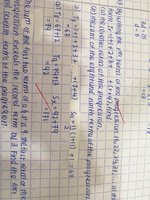To the helpers:
As far as I can tell, "the Tr form" just means the fact given, that T
r = 1+1+2+3+...+(r+4). That is, the
rth term is formed by adding r+4 to the previous term, or alternatively, the rth term is 1 + the (r+4)th triangular number. (The notation T
r merely means "the
rth term of a sequence called
T. It is not some advanced method or concept! The "form" mentioned in the problem is not "T
r", but "1+1+2+3+...+(r+4)".)
To
@Wxlauslen123:
I can't tell, without knowing what you have been learning, whether you are supposed to show how to recognize that fact if it were not given, or how you are expected to use it. We really need you to tell us more!
It may be that you are expected to do nothing more than what you did: just list the terms in the sum that defines the 7th term, which ends with 7+4 = 11, and add them up: 1+1+2+3+4+5+6+7+8+9+10+11 = 67. Since that's what you said you did, and since the numbers are not large, I suspect that is all you had to do. You can do the same for part b, just calculating those terms (by adding 8+4 and 9+4, respectively, to terms you already have).
As you've seen, there are many more advanced ways to do this. We who know more than you do see the problem as calling for knowledge of recursive sequences, summation formulas, and so on, but clearly that is not what is expected of you. Those methods would be appropriate if they asked, say, for T
1000. You are probably just learning the meaning of sequence notation, and a little about arithmetic progressions and the like. If you have learned the formula for the sum of an arithmetic progression, you could use that. But it isn't really necessary.
Can you please tell us what you are currently learning, so we can set these other ideas aside?

